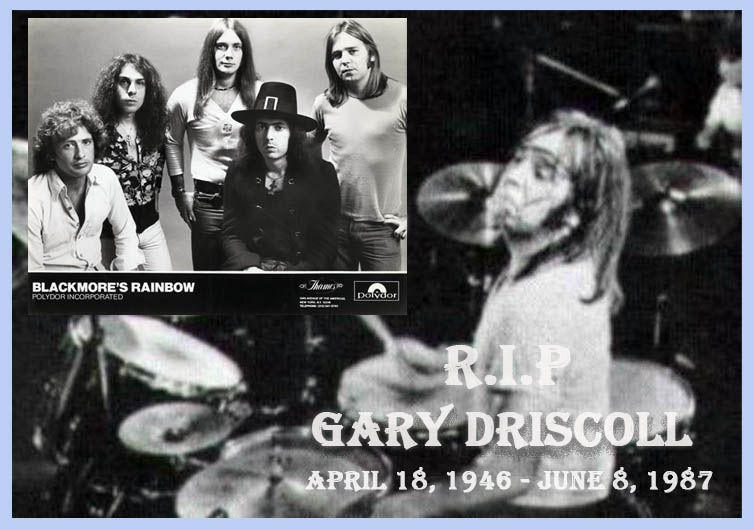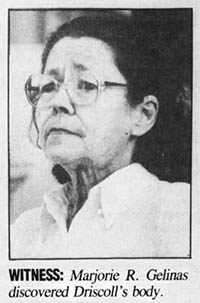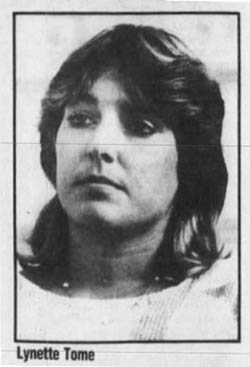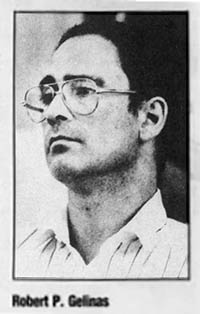Gary Driscoll

Gary Driscoll was murdered in Ithaca, New York, on June 8, 1987. He had a residence nine miles away in Newfield. Driscoll often visited his friend Robert Gelinas in Ithaca, and it was in the basement of this building that Driscoll was found dead, severely beaten and stabbed, with two gunshots to the head. Gelinas sold drugs out of his apartment, and had recently resorted to sleeping in a motel with his girlfriend Lynette Tome in order to hide from persistent customers disturbing him late at night, especially John Shillingford who had argued angrily with Gelinas over a cocaine sale.
Shillingford carried a 32-caliber handgun which he stated was for defense against Charles Harvey who was an associate of Gelinas in the drug trade. Driscoll stopped by the apartment on June 7 as Gelinas and Tome were leaving for the night, and they said he could stay if he wanted to. Shillingford apparently entered the building and beat Driscoll late that night or early the next morning, cut him with a knife, and fired his gun twice at Driscoll's head. The gun was discarded nearby, recovered by police.
Shillingford's fingerprints were identified on Driscoll's car found abandoned a few miles north at Cayuga Shopping Center. Shillingford was acquitted after his attorney successfully challenged the handgun evidence. The handgun had been found on a roadway with a broken grip, and pieces of the grip were also found in a grassy field. Defense alleged that police investigators had planted evidence at the crime scene, involving pieces of the gun grip reportedly found days later on the carpet of the apartment, which had already been searched thoroughly.
Debate opens Driscol trial
 A county prosecutor said Monday that he will prove that John Joseph Shillingford killed John Gary Driscoll and then tried to cover his tracks. Shillingford failed and left a trail of evidence that helped police identify him as the lone killer, the prosecutor said.
A county prosecutor said Monday that he will prove that John Joseph Shillingford killed John Gary Driscoll and then tried to cover his tracks. Shillingford failed and left a trail of evidence that helped police identify him as the lone killer, the prosecutor said.
In opening statements, prosecutor R. James Miller said the evidence investigators collected points to Shillingford as Driscoll's killer. Shillingford, 37, faces eight charges in the June 8, 1987, brutal death of DriscoII, whose body was found in an East State Street duplex bound by soldering wire.
But defense attorney William P. Sullivan Jr. said he isn't convinced by Miller's statements. During Monday's trial, Sullivan asked presiding Tompkins County Judge William C. Barrett to dismiss the eight-count indictment against his client, claiming Miller has circumstantial evidence that "is being shown to tarnish Mr. Shillingford."
Even though Barrett denied Sullivan's dismissal requests, the former county district attorney said Miller doesn't have a case against Shillingford unless he offers direct evidence.
"I suggest to you that at the close of this case," Sullivan told the jury Monday, "there will be no one who is going to come up and say 'I saw John Shillingford kill John Gary Driscoll.'
"Is there enough evidence against Mr. Shillingford? I suggest there isn't," Sullivan said in his nearly five-minute opening statement.
Miller called on three witnesses Monday and is expected to call on six more to testify today. Miller said it might take him another three weeks to present his case to the jury.
David Goodwin, The Ithaca Journal - July 19, 1988
Tome testifies she saw Shillingford with gun
 Lynnette Tome testified Wednesday that the small silver handgun police claim killed John Gary Driscoll was the same gun she saw John Joseph Shillingford carrying in his boot at a party nearly five months before the slaying.
Lynnette Tome testified Wednesday that the small silver handgun police claim killed John Gary Driscoll was the same gun she saw John Joseph Shillingford carrying in his boot at a party nearly five months before the slaying.
Tome is one of the prosecution's key witnesses called to testify in the Shillingford murder trial. Tome, now a resident of Naples, Fla., spent nearly three hours testifying Wednesday and will answer defense attorney William P. Sullivan Jr.'s questions when she returns to the witness stand today. Tome, 23, was living with Robert P. Gelinas at his 422 E. State St. apartment, where Driscoll's badly beaten body was found in the basement, June 8, 1987.
Tome took the stand Wednesday after state police investigator Craig D. Harvey concluded nearly two days of testifying. She is prosecutor R. James Miller's 21st witness and has waited since June 22 to testify. Tome testified that Shillingford would visit the East State Street apartment often because he was buying and selling drugs for Gelinas but would end up in shouting matches with Gelinas over drugs.
She said that two weeks before Driscoll was murdered, Gelinas banned Shillingford from his apartment. Tome said she first met Shillingford - whom she knew as John Shills - in December 1986 at the Union Hall tavern, where Shillingford once lived. Tome said she, Gelinas and Shillingford "went up to his room and did a few lines" of cocaine.
When Sullivan heard this, he asked for a mistrial claiming Tome's testimony incriminated his client. Generally, state statutes don't allow uncharged crimes to be introduced as evidence during a trial, unless attorneys make applications to the presiding judge to rule on its admissibility. The trial recessed for nearly 30 minutes as Tompkins County Judge William C. Barrett, Miller and Sullivan debated the motion. Barrett rejected Sullivan's motion for a mistrial and ordered Tome's statement about her first meeting with Shillingford stricken from the record.
Tome described the day in February 1987 when she saw Shillingford pull the small silver handgun from his boots while he was attending a party at Gelinas' apartment. "Did he tell you why he had the gun?" Sullivan asked Tome. "Yes," Tome replied as she stared out into a crowd of spectators in the courtroom. "John said he was nervous about somebody was going to show up," Tome said. "He said the gun was for his protection against Charles Harvey." Harvey's name was listed in court papers as one of several suspects police considered when they searched for fingerprints in Driscoll's car, which was found parked at Cayuga Mall three days after the slaying.
But police say they found fingerprints only of Shillingford and Driscoll. Harvey, who Tome calls a friend, used to buy and sell cocaine with Gelinas, Tome said. Both Harvey and Gelinas are expected to testify later. Tome said Gelinas took the gun away from Shillingford at the party, removed the bullets and gave the gun back to him. Authorities theorize that Shillingford fired two bullets from this handgun - a .32-caliber Iver Johnson revolver - into Driscoll's head and then discarded the gun by throwing it into a grassy field near Ithaca High School.
Police claim Shillingford's gun, which Tome identified in court, was the same gun used to kill Driscoll June 8, 1987. Tome said that on June 3, 1987, Gelinas decided to check into the Ramada Inn after a shouting match with Shillingford. "He said we needed to get away from people knocking all the time and calling all the time," Tome said. As they were leaving that evening, Tome said, Driscoll drove up. "We told him we were leaving and he was more than welcomed to stay," Tome said she and Gelinas stayed at the Ramada Inn from June 3 to June 8.
David Goodwin, The Ithaca Journal - August 4, 1988
Gelinas takes the Fifth in Shillingford trial
 The prosecutor in the John Joseph Shillingford murder trial said his case might be hurt because he is having trouble proving Shillingford once worked for a suspected drug dealer. Reputed drug dealer Robert P. Gelinas, a key prosecution witness, has made it difficult for attorneys in the case to get him to respond to questions because he is taking the Fifth Amendment.
The prosecutor in the John Joseph Shillingford murder trial said his case might be hurt because he is having trouble proving Shillingford once worked for a suspected drug dealer. Reputed drug dealer Robert P. Gelinas, a key prosecution witness, has made it difficult for attorneys in the case to get him to respond to questions because he is taking the Fifth Amendment.
Gelinas, 42, who faces a drug charge in Tompkins County Court, testified for nearly two hours on Monday and was expected to take the stand in the main courtroom of Tompkins County Courthouse again today. He was called to testify against Shilling-ford, 37, who faces murder, robbery and weapon charges in the slaying of John Gary Driscoll last year. Driscoll was found dead in Gelinas' East State Street apartment June 8, 1987.
Assistant District Attorney R. James Mill er said since Tompkins County Judge William C. Barrett has limited the scope of his questioning, he won't be able to prove one of the key points he outlined in his opening statement last month. Miller, who is handling the prosecution, has theorized that Shillingford killed Driscoll after Gelinas cut off Shillingford as his main cocaine buyer and seller and replaced him with Driscoll. Miller maintains Driscoll's death was drug-related, which he claims Shillingford committed alone.
"It hurts," Miller said following Monday's recess. "The court has ruled that testifying about the defendant's drug use and his dealings with Mr. Gelinas can't be used unless we have a specific date and time," Miller said.
Under the advice of his attorney Martin A. Luster, Gelinas took the Fifth more than 150 times but answered most of the questions. "I respectfully decline to answer on the grounds that I might incriminate myself," a nervous Gelinas said repeatedly as he read from a small index card.
Gelinas faces a drug charge and refused to testify about his drug involvement unless Miller and Barrett granted him immunity. Gelinas is accused of selling $600 worth of cocaine to undercover police last September. That case is pending before Barrett.
Shillingford's defense attorney, William P. Sullivan seemed frustrated by Gelinas' continual use of the Fifth. "This is a charade your honor," Sullivan said. "This witness is controlling the questioning." Many of the attorneys' questions centered on Gelinas' drug involvement before Driscoll's brutal killing.
After many questions, Miller granted Gelinas immunity in order to get an answer. Gelinas told the jury that he had been a drug user for 20 years and had known Driscoll for 35 years. Gelinas said when his wife, Deborah, died in 1986, he inherited her $150,000 insurance policy, which he said he squandered by buying cocaine.
Gelinas said Driscoll worked for him as cocaine buyer and seller. He said neither he nor Driscoll had any outstanding drug debts. Gelinas said he, his girlfriend Lynnette Tome and Driscoll worked his cocaine operation, which he ran out of his apartment.
On Shillingford's birthday, May 26, 1987, Gelinas said Shillingford came to his apartment to buy cocaine. But after arguing with Shillingford, Gelinas apparently banned Shillingford from coming to his apartment. "He wanted to buy cocaine and didn't want to give me any money," Gelinas said.
He said he and Shillingford walked two blocks to a pickup truck where Shillingford said there was some money. But Gelinas said Shillingford had lied and wanted to be fronted the cocaine, which he refused.
Gelinas said when he and Tome decided to go to the Ramada Inn early that June, they told Driscoll he could stay at their apartment if he wanted. Gelinas said Driscoll was expecting a big shipment of drugs that never arrived.
David Goodwin, The Ithaca Journal - August 16, 1988

|